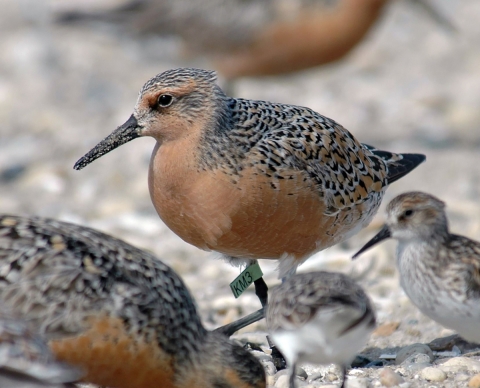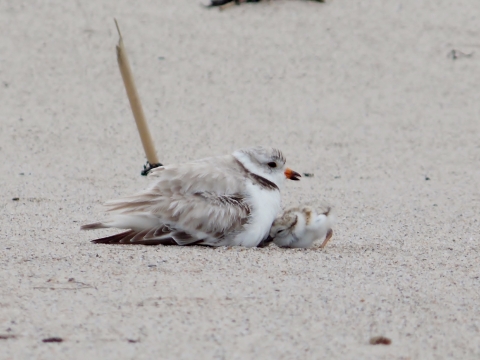When most of us are getting ready for the beach, we think of sunscreen, towels, and snacks. But when a biologist thinks about beach season, they think about how to help protect beach birds. That’s because while we flock to the beaches to swim, sunbathe, and tackle our must-read list, birds go to the beach to survive.
“In the spring, red knots and other migratory birds stop at beaches and other coastal habitats to rest and fuel up during their long journeys,” said Wendy Walsh, an endangered species biologist for the U.S. Fish and Wildlife Service. “This time of year, beach-nesting species like the piping plover also return to sandy beaches to lay eggs and raise chicks.”
Let’s take a closer look at three bird species protected under the Endangered Species Act, why they need our help, and what you can do:
Rufa red knot
Migratory marvels: This robin-sized shorebird can cover more than 9,300 miles in its migration north every spring and repeat the trip in reverse every autumn, making it one of the longest-distance migrants in the animal kingdom. They spend most of the year in flocks, sometimes with other species, and feed on invertebrates like small clams, mussels, and snails, as well also crustaceans, marine worms, and horseshoe crab eggs. On the breeding grounds knots mainly eat insects.
Why they need protection: Coastal development and overharvest of the red knot’s primary food source, the horseshoe crab, led to a 75 percent decline in numbers from the 1980s to the early 2000s. The horseshoe crab harvest is now managed specifically for the protection of the rufa red knot, and their populations appear to have stabilized in recent years, though the total number of individuals are still low.
Piping plover
Protective parents: These small, stocky, sandy-colored birds resemble sandpipers, but cuter. Adult plovers have yellow-orange legs, a black band across the forehead from eye to eye, and a black ring around the base of the neck. They run in short starts and stops and when still, adults and chicks blend into the pale background of open, sandy habitat on outer beaches where they feed and nest. When they sense a threat near their nest, plover parents will pretend to have a broken wing to draw predators away from their young.
Why they need protection: As with the rufa red knot, increased development and beach recreation after World War II caused the population decline that led to Endangered Species Act protection in 1986. Continued barriers to plover recovery include habitat loss, predation, and disturbance to nests.
Roseate Tern
Sky divers: The roseate tern is a medium-sized, gull-like tern about 15 inches long. When not in breeding season, it has a black bill, black legs, white forehead and most of the crown, and a long, deeply forked tail. During this time, the roseate tern is often difficult for scientists distinguish from common terns, among which it nests in the Northeast. Roseate terns nest on small barrier islands, often at ends or breaks. They nest in hollows or under dense vegetation, debris or rocks hidden from predators, and they dive rapidly on their prey — fish — while in flight.
Why they need protection: Conservation challenges such as habitat loss and erosion, nesting competition with larger gulls and predation by mammals and other birds have resulted in declines that necessitated protecting the roseate tern under the Endangered Species Act.
You can help!
The Service is working with partners to recovery these species, but you can help too by keeping their needs in mind when you plan your trip to the shore.
Here are five ways to make the beach more welcoming for birds:
1. Follow all posted rules. By respecting posted areas, knowing what you can and cannot do at the specific beach you are visiting, and understanding that beaches are birds’ homes, you can help keep them safe.
2. Give birds space. Flushing birds when they are trying to eat or rest stresses them out, and prevents them from feeding their chicks or refueling for their long flights.
3. Follow posted rules about keeping dogs on leash. Even good dogs frighten beach birds. A curious canine might accidentally hurt a bird.
4. Don’t leave trash on the beach, including food waste. It attracts predators, like raccoons, that prey on chicks and eggs.
5. Don’t feed birds. Gulls in particular are drawn to your lunch. Our food is not part of their natural diet and more gulls can increase disturbance to some of the imperiled species we are trying to protect.
Birds give back
When you help not just beach birds, but all birds, birds give back. Inaddition to the intrinsic value they provide, birds provide real benefits for everyone.
· Healthy and happy birds support the economy by providing opportunities for travel and bird watching. If you know a birder, just ask them about their “life list” and see where that takes you.
· According to 3billionbirds.org, bird habitat can even boost property values. One study showed that the presence of birds and green space can increase property values by up to $32,000!
· And did you know that birds benefit our food and beverages? It’s true! By keeping insects in check, they support the viability of numerous crops, including coffee and wine. Now I have your attention, right?
Let’s raise a glass (or mug) to birds!








